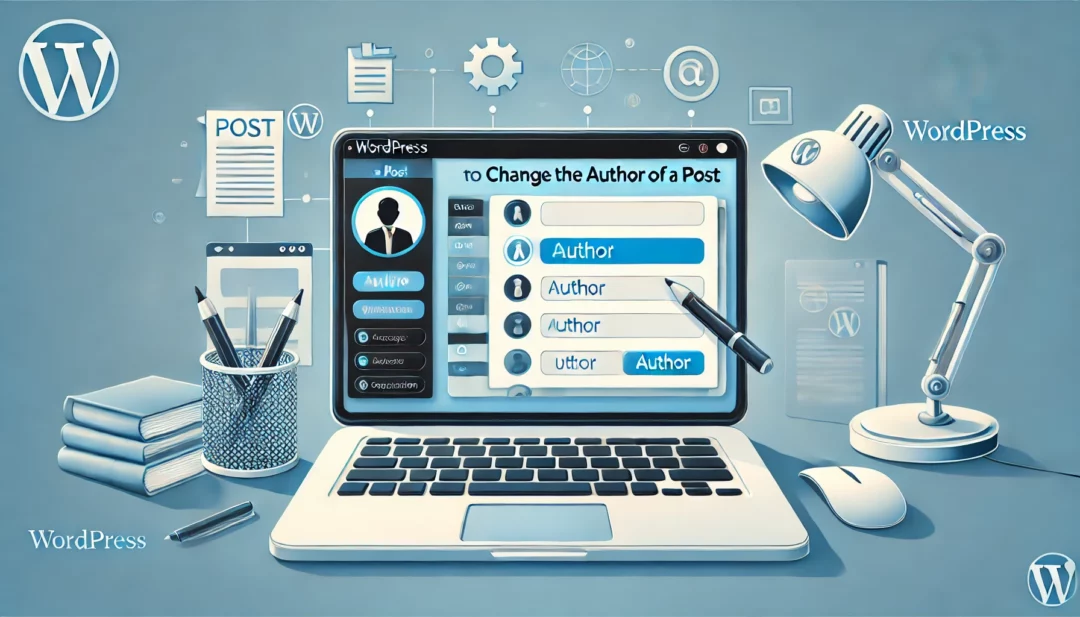
Changing the author of a post in WordPress might seem tricky at first, but it’s a straightforward process that can be done in just a few clicks. Whether you’re managing a multi-author blog or simply need to update a post’s attribution, WordPress provides an easy way to make the switch without altering the content itself.
Why You Might Need To Change The Author Of A Post
Changing the author of a post in WordPress ensures correct attribution and enhances content management flexibility. Situations arise where updating author details becomes essential for maintaining credibility and consistency.
- Correcting Attribution Errors: Mistakes happen during content uploads, attributing a post to the wrong author. For example, a post written by “John” might accidentally be published under “Sarah’s” name.
- Reassigning Content Ownership: Authors might leave a team or transfer responsibilities, requiring proper credit to an active contributor. If a previous author is no longer with your organization, it’s best to assign posts to a relevant team member.
- Guest Posts and Collaboration: Collaborative blogs often publish guest posts or co-authored articles. Updating the author’s name highlights individual authorship or aligns with established contract terms.
- Streamlining Multi-Author Blogs: In multi-author setups like business or magazine-style blogs, assigning the right authors helps categorize and manage content more effectively. For instance, posts can be filtered by individual contributors, improving user navigation.
- Branding and Consistency: Certain posts might require author unification for branding purposes. Assigning posts to a generic user like “Admin” or “Editor” consolidates anonymity when personal author names aren’t needed.
Steps To Change The Author Of A Post In WordPress
Changing the author of a post in WordPress improves content management and ensures correct attribution. Use the methods below to update post authors easily.
Editing From The Post Editor
Access the Post Editor to change the author for individual posts.
- Navigate to Posts in the WordPress admin dashboard and select All Posts.
- Locate the post and click on its Title or the Edit link to open it in the Post Editor.
- In the Document settings panel on the right, scroll to the Author dropdown.
- Choose the new author from the dropdown list. If the desired author isn’t listed, their user account must have the “Author” role or higher.
- Click Update to save the changes.
Using The Quick Edit Option
Quick Edit provides a faster way to change the author for a single post without opening the Post Editor.
- In the WordPress dashboard, go to Posts and click All Posts.
- Hover over the post you want to edit and select Quick Edit beneath its title.
- In the Quick Edit interface, find the Author dropdown and select the new author’s name.
- Click Update to apply the changes.
Changing The Author For Bulk Posts
For multiple posts, Bulk Edit is the most efficient method.
- Open the All Posts section from the WordPress dashboard.
- Use the checkboxes to select the posts you want to edit. To select all visible posts, click the checkbox at the top of the list.
- In the Bulk actions dropdown, choose Edit, then click the Apply button.
- A Bulk Edit panel appears. In the Author dropdown, pick the new author.
- Click the Update button to save the changes for all selected posts.
Keep each method in mind to choose the one most suitable for your task.
Ensuring Proper Author Attribution
Accurate author attribution maintains credibility and ensures readers know who created the content. Changing the author of a post without addressing attribution can confuse audiences or misrepresent authorship. Follow these practices to ensure proper author consistency after modifying ownership.
Verify Author Account Availability
Ensure the desired author exists as a registered user in WordPress. Navigate to Users > All Users in the dashboard to confirm. Add a new user and assign the Author role, if necessary.
Review Previous Author Notes
Check attached notes, such as revisions or custom messages, before changing authorship. Historical notes may include acknowledgments or details requiring updates to reflect the correct author.
Update Custom Author Fields
Adjust metadata or custom fields displaying author names. Access Theme Settings or Post Meta settings if you use fields outside the default WordPress Author dropdown.
Audit for Guest Contributors
For guest posts, confirm proper credits in any bios or user fields used across the site. Modify Author Archive Pages to consolidate works under each contributor’s name.
Check SEO and Schema Updates
Review the updated author’s profile schema markup in themes or SEO plugins. Metadata like author.name ensures accurate representation in search engine results.
Notify Team or Authors
Inform relevant team members or past authors when attribution changes. Transparent communication strengthens trust with contributors.
Troubleshooting Common Issues
Addressing common issues helps resolve errors when changing post authors in WordPress. Follow these troubleshooting steps to maintain smooth functionality.
Author Not Listed in Dropdown Menu
Ensure the desired author is a registered user in WordPress with an active account. Navigate to Users > Add New in your dashboard to add them. Assign the correct role, such as Author or Admin, for proper visibility.
Bulk Changes Not Applying
If bulk author changes don’t save, confirm you selected the correct posts and used the Bulk Actions > Edit feature. Verify permissions for multi-author setups, as certain roles cannot modify post attribution.
Custom Author Fields Not Updated
Some themes or plugins use custom author fields that won’t update automatically. Check your theme’s settings or plugin documentation to adjust manually. Update the metadata in tools like Custom Fields if necessary.
SEO or Schema Issues Post-Change
Changing authors can affect schema markup or post metadata. Use an SEO plugin like Yoast SEO to inspect the new author’s attribution. Reindex with Google Search Console for visibility.
Old Author Notes or Links Remaining
Manually review the post content to remove outdated references to the previous author. Check sections like author bios, content notes, or links embedded in the post.
Permission Denied Errors
Permission errors suggest user roles need adjustment. Assign sufficient capabilities to users in Users > Roles or use role-management plugins like User Role Editor to fix this.
Missing Update Option
Ensure your WordPress installation and plugins are updated. Outdated platforms might lack current author-editing features. Update via Dashboard > Updates to access improvements.
Maintaining accuracy when troubleshooting enhances user experience and preserves site credibility.
Best Practices For Managing Author Roles In WordPress
Proper management of author roles in WordPress ensures efficient collaboration and accurate content attribution. Effective implementation helps streamline workflows in multi-author blogs and enhances site credibility.
Assign Appropriate Roles To Users
Assign roles based on each user’s responsibilities to maintain security and order. WordPress offers five primary user roles: Administrator, Editor, Author, Contributor, and Subscriber. For example:
- Administrator: Grants full permissions; assign cautiously to trusted individuals.
- Editor: Allows editing and publishing all posts; suitable for managing content workflows.
- Author: Limits access to creating and editing their own posts only.
- Contributor: Enables content creation but prevents publishing.
- Subscriber: Restricts permissions to reading content or managing profiles.
Regularly Update User Permissions
Revisit and modify user roles periodically to adapt to team structure changes. Keep inactive user accounts updated to enhance security. For example, switch a departing team member’s role from “Author” to “Subscriber” if content access must be retained.
Use Plugins For Advanced Role Management
Install plugins like User Role Editor or Members for granular control over capabilities. These tools allow custom roles or specific permission adjustments beyond standard WordPress roles.
Monitor Author Contribution Performance
Track author performance to ensure content quality and maintain productivity. Install plugins like PublishPress to monitor contributions or check post edits by individual authors.
Train Authors On Role-Specific Features
Provide training to familiarize authors with their roles. Highlight features relevant to their access level, such as content creation tools for Contributors or advanced publishing options for Editors.
Establish Guidelines For Author Profiles
Implement consistent formatting rules for author profiles. Ensure authors update their bio, profile image, and contact links to maintain a professional appearance across the site.
Encourage Collaboration Through Tools
Use tools like Co-Authors Plus to enable multiple authorship when collaborating on posts. Proper collaboration settings improve team dynamics and reduce errors.
Archive Or Reassign Roles If Necessary
Deactivate or downgrade unneeded accounts to Subscriber or delete them entirely when they no longer serve a purpose. Reassign past content to active authors to preserve attribution history.
Conclusion
Changing the author of a post in WordPress is a straightforward yet essential task for maintaining accurate and professional content management. Whether you’re correcting attributions, managing multi-author workflows, or ensuring branding consistency, this feature gives you the flexibility to adapt as needed.
By following the outlined steps and implementing best practices, you can streamline your process while avoiding common pitfalls. Staying proactive with troubleshooting and role management ensures your site remains credible, organized, and user-friendly. With these tools and tips, you’re well-equipped to handle author changes confidently and efficiently.
Frequently Asked Questions
How do I change the author of a single post in WordPress?
To change the author of a single post, open the post in the WordPress Post Editor. Look for the “Author” dropdown in the editor’s settings panel. Select the new author from the list, then click “Update” to save your changes. Ensure the new author is a registered user in WordPress.
Can I change the author of multiple posts at once?
Yes, you can use the bulk edit feature. Go to “Posts” in WordPress, select the posts you want to update, choose “Edit” from the Bulk Actions dropdown, and click “Apply.” Then, select the new author and click “Update.”
What if I don’t see the desired author in the dropdown menu?
If the author isn’t showing in the dropdown, ensure they are registered as a user in WordPress with a role like Author or higher. You may need to add the user or update their permissions.
Why would I need to change a post’s author?
Changing a post’s author may be necessary to correct attribution errors, assign posts to guest contributors, reassign ownership for departing authors, or streamline branding by unifying authorship across a site.
How can I ensure accurate SEO and schema after changing the author?
After updating the author, check your site’s meta descriptions, schema markup (using tools like Google’s Rich Results Test), and SEO settings to ensure the new author information is accurately reflected.
What should I do if bulk author changes don’t apply?
If bulk changes aren’t applying, ensure WordPress and any plugins are up to date. Check for conflicts with themes or plugins and retry the process. If the issue persists, consult WordPress support.
Are there plugins to manage author roles more effectively?
Yes, plugins like Co-Authors Plus or User Role Editor help manage author roles, allow advanced permissions, and even enable collaborative authorship for posts.
Can guest contributors be listed as authors in WordPress?
Yes, you can create a user account for guest contributors and assign their posts to them. Alternatively, plugins like Co-Authors Plus allow displaying guest author names without creating user accounts.
What should I do if custom author fields don’t update?
If custom fields for authorship are not updating, check your theme’s settings or consult the developer. You may need custom code or plugins to synchronize these fields with the new author data.
How do I manage permissions for post authors?
Assign roles like Author, Editor, or Contributor based on responsibilities. Regularly review and update permissions, use plugins for advanced control, and remove or reassign roles for inactive users to ensure site security.



